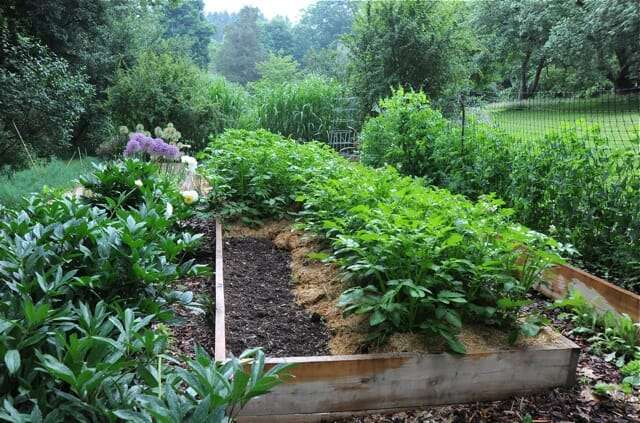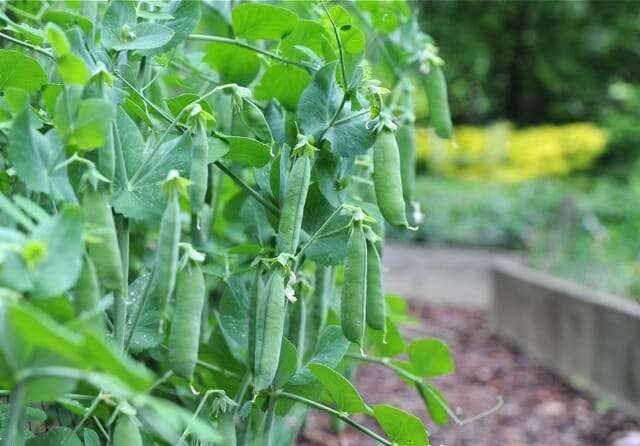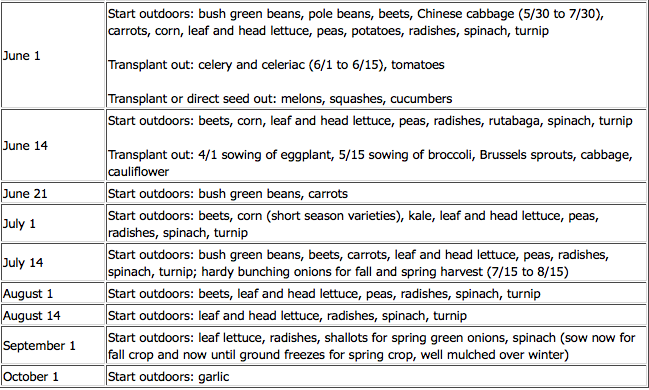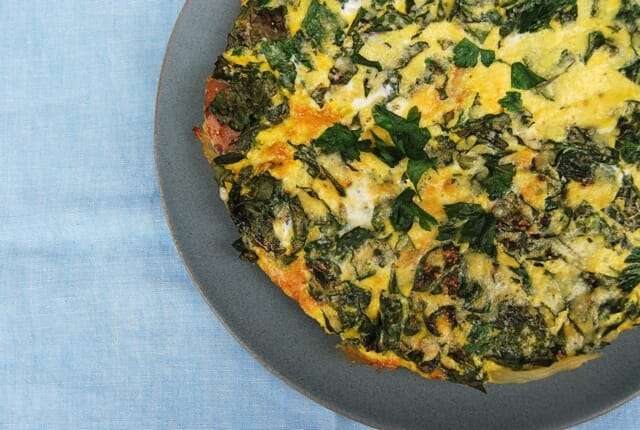vegetable-garden tuneup: make room for more

My mathematical equation starts on paper around June, like this:
1. Make a list of what you want more of (or a first crop of, if it’s a warm-season thing or if you simply didn’t plant an earlier crop).
2. Make a list of things that have gone by or will soon, to assess real estate that you can utilize. In early to mid-June my lists looked like the one below; yours may be very different. My July and August list–for my latest sowings of all–is at at the bottom of the story.
trying to make room here for (as of mid-june*):
- Beans (pole and bush)
- Salad greens—repeat sowings
- Arugula—repeat sowings
- Cilantro
- Basil
- Chard
- Summer and winter squash (I reserved a row for these, where cutting tulips, now faded, grow)
- Maybe one bush cucumber plant?
- Kales and collards
- Tomatoes of not in yet (and peppers and eggplants if you grow them; I don’t)
- (*For last-ditch crops for July and August sowings, see the end of the story)
space coming available here from:
- Peas (two long trellises full) by mid-July
- Spinach
- Arugula
- Endive
- Asian greens
- Garlic (about mid-July or so, but I’m keeping it in mind for a fall prospect…maybe the late peas?)

- Pea trellises might be a good place for pole beans (or other vining crops like squash or cukes)…but then I might want to plant fall peas. Hmmmm…which do I want more?
- Sometimes I place my young tomatoes just alongside the peas, knowing I’ll rip the peas out a few weeks after the tomatoes go in, but before they need all the space. Those years, I yank the pea trellis and insert tomato cages.
4. Also look for marginal spaces you can cheat by a few inches—or a foot. You’d be surprised how much produce you can pack into beds if they contain well-loved soil rich in compost. For instance, between your tomatoes and the path, hanging over the edge even, why not put parsley, the next generation of beets and carrots, cilantro, salad greens, or even a row of bush beans? I do.

6. Remember the basic “best practices” of vegetable-garden care to maximize yields:
- Plant short rows every other week for a sustained but manageable supply of salads, greens, bush beans, cilantro.
- Keep picking! Continual harvesting delays a plant’s instinct to “bolt” or set seed.
- Weed to reduce competition for moisture, light and nutrients (asparagus, onions and garlic, in particular, really suffer with competition).
- Remember which way the sun travels in summer, and don’t accidentally put someone who’ll be small on the shady side of someone who’ll be tall (unless it’s intentional, such as to shade summer salad).
- Water deeply on a regular basis, drenching the entire root zone. (Note: With a sprinkler, this takes many hours. Soaker hoses or drip emitters are more direct if properly placed in beds.)
- There are more tips in the slideshow below (like hilling your potatoes!).

Don’t just toss the arugula that’s started to bolt; have you ever wilted it in garlic and olive oil that contains a chopped tomato or a little tomato sauce and a few red pepper flakes, then tossed it all into pasta, with some grated cheese for good measure? (An old friend handed this combination down to me, as his mother had to him; I smiled when I saw it’s also a formal “recipe,” and if you prefer such details, try this link.)
Or make a “pie” (like the fritatta, above) with the last of the spinach and other green, leafy things. Sauté some onion and garlic in olive oil, wilt the greens right in the same pan when the onion’s tender, crumble in feta (or your choice of cheese), and whisk then add some eggs. Bake in a 350-degree oven in an oiled baking dish, with extra oil drizzled on top. (More recipes for handling the harvest are here. Or you could make an egg-ier “greens frittata” like this.)
Dishes like those simple ones make vegetable-garden tuneup time like its own special harvest season, with a delicious reward for the work, and the promise of more to come.
8. A P.S., sort of: Nonstop seedlings! Most experts–both vegetable farmers and pro gardeners like my friend Lee Reich–say that the greatest productivity and efficiency comes from having transplants on hand to plug in all season long, not just in spring. Watch Lee’s video above, or read more about that in the second half of the chat we had one spring about growing from seed in general.
my ‘never-too-late’ list: my july and august sowings
WHEN I GET TO MY latest sowings, in July and August, after the longest day has passed and the days slowly get shorter, I try to adjust for the fact that things grow differently than in spring. A former High Mowing Organic Seeds staffer turned farmer, Katie Spring, told me to think like this:
“What I learned at High Mowing is what we call ‘The Fall Factor,'” she said. “As the days grow shorter, you add time to the days to maturity on the seed packet. If you’re going based on your first frost date, you can basically add two weeks to the time that crop will take to reach maturity.”
With a 60-day something-or-other, you’d basically make it like a 75-day crop, and count back that long from frost. It’s hard to get it exact, says Katie–but we try, and use The Fall Factor as a guideline. Both Katie and I like to err on the side of maybe starting things a little bit earlier, but not so early that things start to bolt in the high-summer heat.
Select varieties that work with that in mind. My latest list of all, for the fall garden, includes direct-sown things and also some I started earlier in flats, in anticipation. And again: don’t forget to leave room for the garlic! The list:
- Arugula, from 21 to 40 days (baby or mature leaf size)
- Bush beans, about 60 days (have insulating fabric ready if early cold threatens)
- Beets, for roots and beet greens
- Braising greens mix (mustard, kale, collards, Asian greens…)
- Broccoli raab, about 40 days
- Broccoli (60 days from transplants started 15 weeks before first frost.) Try ‘Piracicaba,’ from Hudson Valley Seed Library or Turtle Tree Seed, or the leaf broccoli Spigarello from Johnny’s.
- Cabbage (60 days from transplants started about 15 weeks before first frost) or Napa cabbage (about 10 days faster)
- Carrots (a storage kind like ‘Rolanka’ from Turtle Tree, plus some smaller types for fall eating)
- Cauliflower (60 days from transplants started about 14 weeks before frost)
- Chard
- Chicory, endive, radicchio
- Cilantro
- Collards, about 60 days but nice as a baby green
- Daikon (60 days) and other faster radishes
- Dill
- Kale, about 60 days but nice in half that time as a baby green
- Lettuce, leaf and head type and mesclun mix, about 21-30 days to first cutting
- Mustard greens, about 45 days (faster as baby greens to spice a salad)
- Peas; shelling, sugar snap, and snowpea type; and also a row or block of thickly sown peas for harvest as pea shoots for salad, when they’re 3 or 4 inches tall
- Radish
- Scallions and other hardy bunching onions, for fall use and to overwinter
- Spinach
- Squash, summer variety, fast bush type (I sowed a 48-day variety July 1)
- Turnips, 40-50 days, faster for greens; rutabaga





A reply for Teresa, June 13, 2017 6:06 p.m.
Teresa, this may help you keep weeds under control in a large area that has recently been cleared. If you have trees on your property, use the fallen leaves in autumn. Rake the leaves into piles, run over then with a lawn mower, rake the leaves onto a tarp and drag the tarp to the garden and dump the leaves into the garden. Add a lot of leaves, many inches. The leaves help in three ways; they keep weeds down, they act as mulch for your plants and as the leaves break down they add nutrients and good things to the soil. I’ve been seeing worms in my garden where I’ve added a lot leaves for the past few years. When it’s time to plant in spring, simply rake away the leaves and put in seeds or plants. If you don’t have time to plant the entire area, the leaves will keep the weeds from taking over.
Can I use oak leaves? I’ve heard they’re not good for the soil. I know they take a longer time to break down… All I have is pesky oak trees and pines.
Diane,
I have known experience with pine needles in a vegetable garden; but I’ve used oak, maple, willow, and fruit leaves in many combinations for years. Yes, the oak will take longer to break down; but you can help that by either picking them up by mowing or using a leaf vacuum too break the leaves. smaller pieces and broken edges will really hasten the decay of all your leaves. That’s not a problem with a garden where you should be repeating that mulching yearly.
An experienced gardener just told me I shouldn’t plant sweet peas next to my snap peas (they’re already growing beautifully here in Seattle) because the sweet peas are toxic and will make the snap peas unedible once the bees find both plants. Can I still eat my snap peas?
Hi, Joanie. This makes no sense whatsoever to me. First: garden peas (edible varieties of Pisum sativum) are mostly self-pollinating, and have both male and female parts inside their flowers to make this possible. Bees can get in sometimes if the flowers are open…but the flower structure isn’t very welcoming to them, so it’s not what the plant relies on for pollination. Second, so-called sweet peas grown as cut flowers are in the same family, the legumes, but in a different genus altogether (Lathyrus, specifically L. odoratus). Plants of different species (let alone different genera) are by definition not closely enough related to cross-pollinate. So I think not. Wonder where your friend ran into this idea — almost a superstitious notion, and I suspect one that arose from the internet.
Margaret, thank you for the timely seeding information. Truly news you can use!
You are welcome, Lee Ann. We’re having a heatwave but I am determined to get out early in the mornings and get some empty spaces filled up, and to sow some cellpacks for future plugging in, too.
Love the info, but we live in ND in Zone 3. A later planting, let alone an early one for that mater, is difficult.!! A girl can dream…